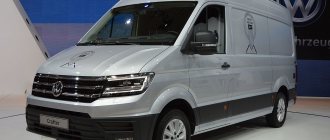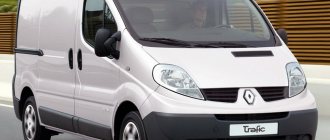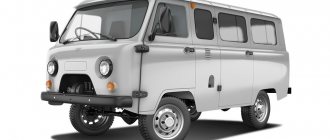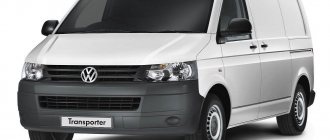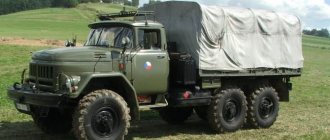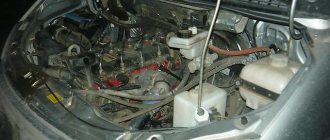Rated fuel consumption is one of the most informative and important characteristics of a car for the driver. This is what manufacturers often use to advertise and promote a particular new car model.
Among owners of used cars, it is considered acceptable to consume up to 10 liters of gasoline or diesel per 100 kilometers. In foreign countries, this indicator is indicated in miles, so recalculation into “native” units is often necessary. The fuel consumption tables available in this section of the site are considered very useful.
What does the fuel consumption indicator indicate? What does this characteristic mean? We are talking about hydrocarbon fuel consumption. For example, for an SUV the figure corresponds to 9.5 liters per 100 km. It is quite acceptable, primarily due to the weight and power of the car. The indicator can be reduced due to the following:
- use of energy recovery systems during braking;
- lightening the weight of the car when replacing body and chassis elements with innovative materials;
- engine improvements;
- replacing the exhaust system.
For new models, consumption of 6 l/100 km is considered quite a “cruising” figure, but it will be higher for heavy SUVs and pickups and lower for small hybrids. The necessary information can be found in the tables provided.
What to do if fuel consumption is higher than rated? If the car consumes more fuel and does not correspond to the nominal value indicated in the table, this means there is a malfunction. Experienced service center technicians will tell you how serious it is and how it can be eliminated. In some cases, tuning makes it possible to further optimize fuel consumption, but this is usually achieved by lightening the body structure or by replacing the engine. Professional automotive technicians can provide specific recommendations.
Fuel consumption of the Volkswagen Transporter ranges from 5.8 to 10.7 liters per 100 km.
Volkswagen Transporter is available with the following types of fuel: Diesel fuel, Gasoline AI-95.
Fuel consumption Volkswagen Transporter restyling 2022, flatbed truck, 6th generation, T6.1
| Engine capacity | Power | Transmission | Drive unit | Fuel | Consumption |
| 2.0 l | 110 hp | Manual transmission | front-wheel drive | Diesel fuel | 7,1 |
| 2.0 l | 150 hp | Manual transmission | front-wheel drive | Diesel fuel | 7,2 |
| 2.0 l | 110 hp | Manual transmission | front-wheel drive | Diesel fuel | 7,2 |
| 2.0 l | 150 hp | Manual transmission | front-wheel drive | Diesel fuel | 7,3 |
| 2.0 l | 110 hp | Manual transmission | front-wheel drive | Diesel fuel | 7,3 |
| 2.0 l | 150 hp | robot | four-wheel drive (4WD) | Diesel fuel | 7,8 |
| 2.0 l | 150 hp | robot | four-wheel drive (4WD) | Diesel fuel | 7,9 |
| 2.0 l | 150 hp | robot | four-wheel drive (4WD) | Diesel fuel | 8,0 |
| 2.0 l | 199 hp | robot | four-wheel drive (4WD) | Diesel fuel | 8,2 |
Sale Volkswagen Transporter T4 • Diesel engine acv 20
| Volkswagen fuel consumption; — VW Passat, Polo, Touareg, Tiguan, Jetta, Golf at 100 km As a result of the reaction, a metal-ceramic protective layer is formed on the friction surfaces, which has increased hardness, low friction force, anti-corrosion properties, and fire resistance. It is also impossible not to say that these power units are the most wear-resistant and reliable in general, in comparison with other engines that were born. |
Chassis • They have an original modern design and fairly good technical equipment, and most importantly, they are affordable.
Fuel consumption Volkswagen Transporter restyling 2022, minivan, 6th generation, T6.1
| Engine capacity | Power | Transmission | Drive unit | Fuel | Consumption |
| 2.0 l | 110 hp | Manual transmission | front-wheel drive | Diesel fuel | 6,5 |
| 2.0 l | 150 hp | Manual transmission | front-wheel drive | Diesel fuel | 6,6 |
| 2.0 l | 110 hp | Manual transmission | front-wheel drive | Diesel fuel | 6,8 |
| 2.0 l | 150 hp | Manual transmission | front-wheel drive | Diesel fuel | 6,9 |
| 2.0 l | 199 hp | robot | four-wheel drive (4WD) | Diesel fuel | 7,2 |
| 2.0 l | 150 hp | robot | four-wheel drive (4WD) | Diesel fuel | 7,3 |
| 2.0 l | 199 hp | robot | four-wheel drive (4WD) | Diesel fuel | 7,6 |
| 2.0 l | 150 hp | robot | four-wheel drive (4WD) | Diesel fuel | 7,7 |
Read more about vehicle characteristics Review of volkswagen t2
| Volkswagen T4 fuel consumption Standard equipment also includes dual-zone Climatronic air conditioning, radio, six speakers, multifunction display and cruise control. The new cabover Transporter already had front transverse water-cooled in-line engines from the Volkswagen Passat and Audi 80 100 passenger models, developing power from 45 to 81 kW. |
| T5 AXE fuel consumption again. This is also logical, after all, it was impossible to develop a high speed, accordingly, the car walked softly, smoothly and quietly, and therefore could travel such long distances without revealing certain problems. The fundamental difference from previous models is the fact that T4 cars received a cabover layout, which was characterized by a front transverse arrangement of power units. |
- oil consumption;
- blue white smoke;
- decreased cravings;
- uneven work;
- The engine will not start.
The first generation rolled off the assembly line in 1950, at that time the model's load capacity was 860 kg, which was a lot. The model's windshield was divided into 2 parts, and in the front of the car there was a large Volkswagen badge.
The second generation became significant for the entire model. A new version of the Volkswagen Transporter appeared in 1967, the designers retained the main features of the chassis and design. The popularity of the 2nd generation was enormous, approximately 70% of the cars were exported. The main differences are a modified engine line, larger dimensions, and a modified suspension. Production of the model was stopped in 1979, but in some countries, namely Mexico and Brazil, they began producing this modification in 1997, and stopped production in 2013.
With the onset of the 80s, the 3rd generation of the Volkswagen Transporter came out, which contained a lot of new things.
- Extended wheelbase.
- Increased dimensions and load capacity.
- The engine remained at the rear of the car, as in the second generation.
- A lot of additional equipment appeared, including electric mirrors and power windows.
Later there was a restyling, so the car survived the introduction of all-wheel drive and air conditioning. The main disadvantage of the Volkswagen Transporter is the poor quality of the metal; some parts quickly became rusty. By the 90s, the version became unpopular, so manufacturers had to create a new generation.
Fuel consumption Volkswagen Transporter 2015, flatbed truck, 6th generation, T6
| Engine capacity | Power | Transmission | Drive unit | Fuel | Consumption |
| 2.0 l | 102 hp | Manual transmission | front-wheel drive | Diesel fuel | 7,3 |
| 2.0 l | 140 hp | Manual transmission | front-wheel drive | Diesel fuel | 7,5 |
| 2.0 l | 180 hp | robot | front-wheel drive | Diesel fuel | 7,9 |
| 2.0 l | 140 hp | robot | front-wheel drive | Diesel fuel | 8,0 |
| 2.0 l | 140 hp | Manual transmission | four-wheel drive (4WD) | Diesel fuel | 8,1 |
| 2.0 l | 180 hp | robot | four-wheel drive (4WD) | Diesel fuel | 8,6 |
| 2.0 l | 150 hp | Manual transmission | front-wheel drive | Gasoline AI-95 | 9,6 |
Machine Features
It can be used as a car exclusively for family or travel, because the Volkswagen Transporter T4 Bestel can have up to 11 seats except the driver, or up to 5 seats in the cargo compartment with large capacity. The designers finally managed to overcome the jerky operation of such a box at low speeds in urban conditions, switching is carried out smoothly, without jerking.
Fuel consumption Volkswagen Transporter 2015, all-metal van, 6th generation, T6
| Engine capacity | Power | Transmission | Drive unit | Fuel | Consumption |
| 2.0 l | 102 hp | Manual transmission | front-wheel drive | Diesel fuel | 7,3 |
| 2.0 l | 140 hp | Manual transmission | front-wheel drive | Diesel fuel | 7,5 |
| 2.0 l | 102 hp | Manual transmission | front-wheel drive | Diesel fuel | 7,7 |
| 2.0 l | 180 hp | robot | front-wheel drive | Diesel fuel | 7,9 |
| 2.0 l | 140 hp | Manual transmission | front-wheel drive | Diesel fuel | 7,9 |
| 2.0 l | 140 hp | robot | front-wheel drive | Diesel fuel | 8,0 |
| 2.0 l | 140 hp | Manual transmission | four-wheel drive (4WD) | Diesel fuel | 8,1 |
| 2.0 l | 180 hp | robot | front-wheel drive | Diesel fuel | 8,2 |
| 2.0 l | 140 hp | robot | front-wheel drive | Diesel fuel | 8,3 |
| 2.0 l | 140 hp | Manual transmission | four-wheel drive (4WD) | Diesel fuel | 8,4 |
| 2.0 l | 180 hp | robot | four-wheel drive (4WD) | Diesel fuel | 8,6 |
| 2.0 l | 180 hp | robot | four-wheel drive (4WD) | Diesel fuel | 8,9 |
| 2.0 l | 150 hp | Manual transmission | front-wheel drive | Gasoline AI-95 | 9,6 |
| 2.0 l | 204 hp | robot | front-wheel drive | Gasoline AI-95 | 9,8 |
| 2.0 l | 150 hp | Manual transmission | front-wheel drive | Gasoline AI-95 | 10,0 |
| 2.0 l | 204 hp | robot | front-wheel drive | Gasoline AI-95 | 10,2 |
| 2.0 l | 204 hp | robot | four-wheel drive (4WD) | Gasoline AI-95 | 10,3 |
| 2.0 l | 204 hp | robot | four-wheel drive (4WD) | Gasoline AI-95 | 10,7 |
Historical reference
The first generation rolled off the assembly line in 1950, at that time the model's load capacity was 860 kg, which was a lot. The model's windshield was divided into 2 parts, and in the front of the car there was a large Volkswagen badge.
The second generation became significant for the entire model. A new version of the Volkswagen Transporter appeared in 1967, the designers retained the main features of the chassis and design. The popularity of the 2nd generation was enormous, approximately 70% of the cars were exported. The main differences are a modified engine line, larger dimensions, and a modified suspension. Production of the model was stopped in 1979, but in some countries, namely Mexico and Brazil, they began producing this modification in 1997, and stopped production in 2013.
With the onset of the 80s, the 3rd generation of the Volkswagen Transporter came out, which contained a lot of new things.
:
- Extended wheelbase.
- Increased dimensions and load capacity.
- The engine remained at the rear of the car, as in the second generation.
- A lot of additional equipment appeared, including electric mirrors and power windows.
Later there was a restyling, so the car survived the introduction of all-wheel drive and air conditioning. The main disadvantage of the Volkswagen Transporter is the poor quality of the metal; some parts quickly became rusty. By the 90s, the version became unpopular, so manufacturers had to create a new generation.
The 4th generation Volkswagen transporter caused a sensation among many fans of the brand and model
:
- The appearance and design have completely changed.
- All models were front-wheel drive.
- You could buy all-wheel drive.
- Several types of body, for freight transport and for transporting people.
At the end of 1990, minor changes took place, and the Volkswagen Transporter was slightly modified.
The 4th generation was replaced by the Volkswagen Transporter T5, which debuted in 2003. Technical updates have been added, the engines are equipped with new injection, supercharger and much more. More expensive modifications had an automatic transmission.
The latest generation T6 has not received many major changes in comparison with the Volkswagen Transporter T5. The technical components have remained almost unchanged; the body and decorative elements have changed somewhat.
Fuel consumption Volkswagen Transporter 2015, minivan, 6th generation, T6
| Engine capacity | Power | Transmission | Drive unit | Fuel | Consumption |
| 2.0 l | 150 hp | robot | front-wheel drive | Diesel fuel | 5,8 |
| 2.0 l | 204 hp | robot | front-wheel drive | Diesel fuel | 6,3 |
| 2.0 l | 150 hp | robot | four-wheel drive (4WD) | Diesel fuel | 6,3 |
| 2.0 l | 204 hp | robot | four-wheel drive (4WD) | Diesel fuel | 6,6 |
| 2.0 l | 102 hp | Manual transmission | front-wheel drive | Diesel fuel | 7,3 |
| 2.0 l | 140 hp | Manual transmission | front-wheel drive | Diesel fuel | 7,5 |
| 2.0 l | 102 hp | Manual transmission | front-wheel drive | Diesel fuel | 7,7 |
| 2.0 l | 180 hp | robot | front-wheel drive | Diesel fuel | 7,9 |
| 2.0 l | 140 hp | Manual transmission | front-wheel drive | Diesel fuel | 7,9 |
| 2.0 l | 140 hp | robot | front-wheel drive | Diesel fuel | 8,0 |
| 2.0 l | 140 hp | Manual transmission | four-wheel drive (4WD) | Diesel fuel | 8,1 |
| 2.0 l | 180 hp | robot | front-wheel drive | Diesel fuel | 8,2 |
| 2.0 l | 140 hp | robot | front-wheel drive | Diesel fuel | 8,3 |
| 2.0 l | 140 hp | Manual transmission | four-wheel drive (4WD) | Diesel fuel | 8,4 |
| 2.0 l | 180 hp | robot | four-wheel drive (4WD) | Diesel fuel | 8,6 |
| 2.0 l | 180 hp | robot | four-wheel drive (4WD) | Diesel fuel | 8,9 |
| 2.0 l | 150 hp | Manual transmission | front-wheel drive | Gasoline AI-95 | 9,6 |
| 2.0 l | 204 hp | robot | front-wheel drive | Gasoline AI-95 | 9,8 |
| 2.0 l | 150 hp | Manual transmission | front-wheel drive | Gasoline AI-95 | 10,0 |
| 2.0 l | 204 hp | robot | front-wheel drive | Gasoline AI-95 | 10,2 |
| 2.0 l | 204 hp | robot | four-wheel drive (4WD) | Gasoline AI-95 | 10,3 |
| 2.0 l | 204 hp | robot | four-wheel drive (4WD) | Gasoline AI-95 | 10,7 |
Body
All Volkswagen T5 models are prone to the accumulation of body defects. The metal is not prone to corrosion (galvanized), but the paint flies off it regularly.
Many owners complain about failed power windows or power sliding doors (knocking, vibrating, slowing down or completely refusing to obey). With age, side window seals leak and sliding door rollers wear out.
Door latches must be lubricated during every maintenance. It seems that in this case they forgot about it.
The quality of the interior parts is also not up to ideal. In this case, the rule applies: the more products that increase functionality and comfort, the more failures. The central locking system, the folding table of the Multivan and the electric seats of the Business modification suffer. In general, do not trust the owner’s words, but check the operation of all systems yourself.
A folding table is a popular accessory, expensive and very unreliable.
Don't expect much from older head units with navigation systems. Until 2005, they could only play CDs. Later came DVD-ROM. Playing CDs became possible only after intervention - flashing the head unit. Later systems work and think faster, but by modern standards this is Stone Age technology. Frequent problems with the GPS antenna are another argument to retire the factory system and install a more modern device instead.
The rest of the interior suffers from typical Volkswagen defects, such as rattling plastic parts and wear on the soft surfaces.
Head unit with characteristic wear on the key cover.
The rear air conditioning pipes, located in the arch of the right rear wheel, can become leaky after 5-8 years. Many services offer installation of more durable hoses, for which they charge 20-30 thousand rubles. And the rear heater stops working due to poor moisture protection of the control unit. The board oxidizes and the contacts corrode. The problem is typical for cars assembled after 2007. Often it is possible to restore the unit’s functionality on its own; in extreme cases, you have to replace the unit itself (from 31,000 rubles).
Fuel consumption Volkswagen Transporter restyling 2009, all-metal van, 5th generation, T5
| Engine capacity | Power | Transmission | Drive unit | Fuel | Consumption |
| 2.0 l | 102 hp | Manual transmission | front-wheel drive | Diesel fuel | 7,3 |
| 2.0 l | 84 hp | Manual transmission | front-wheel drive | Diesel fuel | 7,3 |
| 2.0 l | 140 hp | robot | front-wheel drive | Diesel fuel | 7,5 |
| 2.0 l | 140 hp | Manual transmission | front-wheel drive | Diesel fuel | 7,5 |
| 2.0 l | 180 hp | robot | front-wheel drive | Diesel fuel | 7,6 |
| 2.0 l | 180 hp | Manual transmission | front-wheel drive | Diesel fuel | 7,6 |
| 2.0 l | 204 hp | robot | front-wheel drive | Gasoline AI-95 | 9,6 |
| 2.0 l | 204 hp | Manual transmission | front-wheel drive | Gasoline AI-95 | 9,6 |
| 2.0 l | 150 hp | Manual transmission | front-wheel drive | Gasoline AI-95 | 9,6 |
| 2.0 l | 204 hp | robot | four-wheel drive (4WD) | Gasoline AI-95 | 10,3 |
| 2.0 l | 115 hp | Manual transmission | front-wheel drive | Gasoline AI-95 | 10,4 |
Fuel consumption Volkswagen Transporter restyling 2009, flatbed truck, 5th generation, T5
| Engine capacity | Power | Transmission | Drive unit | Fuel | Consumption |
| 2.0 l | 84 hp | Manual transmission | front-wheel drive | Diesel fuel | 7,3 |
| 2.0 l | 102 hp | Manual transmission | front-wheel drive | Diesel fuel | 7,3 |
| 2.0 l | 140 hp | robot | front-wheel drive | Diesel fuel | 7,5 |
| 2.0 l | 140 hp | Manual transmission | front-wheel drive | Diesel fuel | 7,5 |
| 2.0 l | 180 hp | robot | front-wheel drive | Diesel fuel | 7,6 |
| 2.0 l | 180 hp | Manual transmission | front-wheel drive | Diesel fuel | 7,6 |
| 2.0 l | 150 hp | Manual transmission | front-wheel drive | Gasoline AI-95 | 9,6 |
| 2.0 l | 115 hp | Manual transmission | front-wheel drive | Gasoline AI-95 | 10,4 |
Fuel consumption Volkswagen Transporter restyling 2009, minivan, 5th generation, T5
| Engine capacity | Power | Transmission | Drive unit | Fuel | Consumption |
| 2.0 l | 84 hp | Manual transmission | front-wheel drive | Diesel fuel | 7,3 |
| 2.0 l | 102 hp | Manual transmission | front-wheel drive | Diesel fuel | 7,3 |
| 2.0 l | 140 hp | Manual transmission | front-wheel drive | Diesel fuel | 7,5 |
| 2.0 l | 140 hp | robot | front-wheel drive | Diesel fuel | 7,5 |
| 2.0 l | 180 hp | Manual transmission | front-wheel drive | Diesel fuel | 7,6 |
| 2.0 l | 180 hp | robot | front-wheel drive | Diesel fuel | 7,6 |
| 2.0 l | 84 hp | Manual transmission | front-wheel drive | Diesel fuel | 7,7 |
| 2.0 l | 102 hp | Manual transmission | front-wheel drive | Diesel fuel | 7,7 |
| 2.0 l | 180 hp | Manual transmission | front-wheel drive | Diesel fuel | 7,9 |
| 2.0 l | 140 hp | Manual transmission | front-wheel drive | Diesel fuel | 7,9 |
| 2.0 l | 180 hp | robot | front-wheel drive | Diesel fuel | 8,2 |
| 2.0 l | 140 hp | robot | front-wheel drive | Diesel fuel | 8,2 |
| 2.0 l | 140 hp | Manual transmission | four-wheel drive (4WD) | Diesel fuel | 8,4 |
| 2.0 l | 180 hp | Manual transmission | four-wheel drive (4WD) | Diesel fuel | 8,9 |
| 2.0 l | 204 hp | robot | front-wheel drive | Gasoline AI-95 | 9,6 |
| 2.0 l | 204 hp | Manual transmission | front-wheel drive | Gasoline AI-95 | 9,6 |
| 2.0 l | 150 hp | Manual transmission | front-wheel drive | Gasoline AI-95 | 9,6 |
| 2.0 l | 204 hp | Manual transmission | front-wheel drive | Gasoline AI-95 | 10,0 |
| 2.0 l | 150 hp | Manual transmission | front-wheel drive | Gasoline AI-95 | 10,0 |
| 2.0 l | 204 hp | robot | front-wheel drive | Gasoline AI-95 | 10,2 |
| 2.0 l | 204 hp | robot | four-wheel drive (4WD) | Gasoline AI-95 | 10,3 |
| 2.0 l | 115 hp | Manual transmission | front-wheel drive | Gasoline AI-95 | 10,4 |
| 2.0 l | 204 hp | robot | four-wheel drive (4WD) | Gasoline AI-95 | 10,7 |
